Triply Periodic Minimal Surfaces Mullite Structures for Humidity Detection
Abstract
1. Introduction
2. Materials and Methods
2.1. Fabrication of Ceramic Substrates
2.1.1. Mullite Powders Characterization
2.1.2. Mullite Slurry Elaboration
2.1.3. Digital Light Processing (DLP) of TPMS Mullite Architectures
2.1.4. Post-Processing, Sintering and Characterization
2.2. Fabrication and Measurement of Humidity Sensors
3. Results and Discussion
3.1. Sensors Characterization
3.2. Humidity-Sensing Properties
4. Conclusions
Author Contributions
Funding
Institutional Review Board Statement
Informed Consent Statement
Data Availability Statement
Conflicts of Interest
References
- Tulliani, J.-M.; Inserra, B.; Ziegler, D. Carbon-Based Materials for Humidity Sensing: A Short Review. Micromachines 2019, 10, 232. [Google Scholar] [CrossRef] [PubMed]
- Korotcenkov, G. Handbook of Gas Sensor Materials, Properties, Advantages and Shortcomings for Applications, Volume 2: New Trends and Technologies; Springer: Berlin/Heidelberg, Germany, 2014. [Google Scholar]
- Traversa, E. Ceramic sensors for humidity detection: The state-of-the-art and future developments. Sens. Actuators B 1995, 23, 135–156. [Google Scholar] [CrossRef]
- Sajid, M.; Khattak, Z.J.; Rahman, K.; Hassan, G.; Choi, K.H. Progress and future of relative humidity sensors: A review from materials perspective. Bull. Mater. Sci. 2022, 45, 238. [Google Scholar] [CrossRef]
- Tulliani, J.-M.; Baroni, C.; Zavattaro, L.; Grignani, C. Strontium-Doped Hematite as a Possible Humidity Sensing Material for Soil Water Content Determination. Sensors 2013, 13, 12070–12092. [Google Scholar] [CrossRef] [PubMed]
- Korotcenkov, G. Handbook of Gas Sensor Materials, Properties, Advantages and Shortcomings for Applications, Volume 1: Conventional Approaches; Springer: Berlin/Heidelberg, Germany, 2013; pp. 389–408. [Google Scholar]
- Fraden, J. Handbook of Modern Sensors. Physics, Designs and Applications, 5th ed.; Springer: Berlin/Heidelberg, Germany, 2016; pp. 507–524. [Google Scholar]
- Kuzubasoglu, B.A. Recent Studies on the Humidity Sensor: A Mini Review. ACS Appl. Electron. Mater. 2022, 4, 4797–4807. [Google Scholar] [CrossRef]
- Qi, P.; Xu, Z.; Zhang, T. In Situ Growth of Dopamine on QCM for Humidity Detection. Chemosensors 2022, 10, 522. [Google Scholar] [CrossRef]
- Zhang, M.; Duan, Z.; Yuan, Z.; Jiang, Y.; Tai, H. Observing Mixed Chemical Reactions at the Positive Electrode in the High-Performance Self-Powered Electrochemical Humidity Sensor. ACS Nano 2024, 18, 34158–34170. [Google Scholar] [CrossRef]
- Ateia, E.E.; Arman, M.M.; Morsy, M. Synthesis, characterization of NdCoO3 perovskite and its uses as humidity sensor. Appl. Phys. A 2019, 125, 883. [Google Scholar] [CrossRef]
- Dhariwal, N.; Yadav, P.; Kumari, M.; Jain, P.; Sanger, A.; Kumar, V.; Thakur, O.P. Iron oxide-based nanoparticles for fast-response humidity sensing, real-time respiration monitoring, and noncontact sensing. IEEE Sens. J. 2023, 23, 22217–22224. [Google Scholar] [CrossRef]
- Li, J.; Ling, W.; Wen, S.; Nie, H.; Li, J. Performance analysis of Fe2O3/CNT humidity sensor based on adsorption kinetics and DFT computations. Ceram. Int. 2024, 50, 7239. [Google Scholar] [CrossRef]
- Pathan, A.S.; Gapale, D.L.; Bhosale, S.V.; Landge, A.S.; Jadkar, S.R.; Arote, S.A. Studies on resistive-type humidity sensing properties of copper-zinc mixed metal oxide nanostructures. Inorg. Chem. Commun. 2023, 153, 110824. [Google Scholar] [CrossRef]
- Kumar, A.; Kumari, P.; Kumar, M.S.; Gupta, G.; Shivagan, D.D.; Bapna, K. SnO2 nanostructured thin film as humidity sensor and its application in breath monitoring. Ceram. Int. 2023, 49, 24911–24921. [Google Scholar] [CrossRef]
- Pascariu, P.; Tudorache, F.; Romanitan, C.; Serban, A.B.; Koudoumas, E. 1% lanthanide-doped ZnO nanostructures as a versatile approach for state-of-the-art capacitive and resistive humidity sensors. Ceram. Int. 2025, in press. [Google Scholar] [CrossRef]
- Burman, D.; Choudhary, D.S.; Guha, P.K. ZnO/MoS2-based enhanced humidity sensor prototype with android app interface for mobile platform. IEEE Sens. J. 2019, 19, 3993–3999. [Google Scholar] [CrossRef]
- Angadi, V.J.; Tudorache, F.; Ubaidullah, M.; Pandit, B.; Manjunatha, S.O.; Wang, S. Role of holmium on the humidity sensing properties of the CoCr2O4 ceramics for possible applications in humidity sensors. J. Mater. Sci. Mater. Electron. 2023, 34, 1583. [Google Scholar] [CrossRef]
- Manjunatha, K.; Ho, M.K.; Hsu, T.E.; Kumar, A.; Wu, S.Y.; Hardi, S.S.; Chethan, B.; Prasad, V.; Pandit, B.; Ubaidullah, M.; et al. Structure, microstructure, and enhanced sensing behavior of nickle ferrite-cobalt chromate for humidity sensor applications. J. Mater. Sci. Mater. Electron. 2024, 35, 471. [Google Scholar] [CrossRef]
- Hiremath, V.G.; Yahia, I.S.; Zahran, H.Y.; Chethan, B.; Malimath, G.H.; Ravikiran, Y.T.; Angadi, V.J. Humidity sensing behaviour of Rubidium-doped Magnesium ferrite for sensor applications. J. Mater. Sci. Mater. Electron. 2022, 33, 11591–11600. [Google Scholar] [CrossRef]
- Duan, Z.; Zhao, Q.; Wang, S.; Huang, Q.; Yuan, Z.; Zhang, Y.; Jiang, Y.; Tai, H. Halloysite nanotubes: Natural, environmental-friendly and low-cost nanomaterials for high-performance humidity sensor. Sens. Actuators B Chem. 2020, 317, 128204. [Google Scholar] [CrossRef]
- Duan, Z.; Zhao, Q.; Wang, S.; Yuan, Z.; Zhang, Y.; Li, X.; Wu, Y.; Jiang, Y.; Tai, H. Novel application of attapulgite on high performance and low-cost humidity sensors. Sens. Actuators B Chem. 2020, 305, 127534. [Google Scholar] [CrossRef]
- Duan, Z.; Jiang, Y.; Zhao, Q.; Wang, S.; Yuan, Z.; Zhang, Y.; Liu, B.; Tai, H. Facile and low-cost fabrication of a humidity sensor using naturally available sepiolite nanofibers. Nanotechnology 2020, 31, 355501. [Google Scholar] [CrossRef]
- Al-Ketan, O.; Lee, D.; Rowshan, R.; Al-Rub, R.K.A. Functionally graded and multi-morphology sheet TPMS lattices: Design, manufacturing, and mechanical properties. J. Mech. Behav. Biomed. Mater. 2020, 102, 103520. [Google Scholar] [CrossRef] [PubMed]
- Feng, J.; Fu, J.; Yao, X.; He, Y. Triply periodic minimal surface (TPMS) porous structures: From multi-scale design, precise additive manufacturing to multidisciplinary applications. Int. J. Extrem. Manuf. 2022, 4, 022001. [Google Scholar] [CrossRef]
- Ngo, T.D.; Kashani, A.; Imbalzano, G.; Nguyen, K.T.Q.; Hui, D. Additive manufacturing (3D printing): A review of materials, methods, applications and challenges. Compos. B Eng. 2018, 143, 172–196. [Google Scholar] [CrossRef]
- Chen, Z.; Li, Z.; Li, J.; Liu, C.; Lao, C.; Fu, Y.; Liu, C.; Yang, L.; Wang, P.; Yi, H. 3D printing of ceramics: A review. J. Eur. Ceram. Soc. 2019, 39, 661–687. [Google Scholar] [CrossRef]
- Zhou, S.X.; Yao, L.; Zhao, T.; Mei, H.; Cheng, L.F.; Zhang, L.T. Ti doped SiOC precursor to activate gyroid sensing structures. Carbon 2022, 196, 253–263. [Google Scholar] [CrossRef]
- Peng, K.; Yu, T.; Wu, P.; Chen, M. Piezoresistive Porous Composites with Triply Periodic Minimal Surface Structures Prepared by Self-Resistance Electric Heating and 3D Printing. Sensors 2024, 24, 2184. [Google Scholar] [CrossRef]
- Fortunato, M.; Pacitto, L.; Pesce, N.; Tamburrano, A. 3D-Printed Graphene Nanoplatelets/Polymer Foams for Low/Medium-Pressure Sensors. Sensors 2023, 23, 7054. [Google Scholar] [CrossRef]
- Imanian, M.E.; Kardan-Halvaei, M.; Nasrollahi, F.; Imanian, A.; Montazerian, H.; Nasrollahi, V. 3D printed flexible wearable sensors based on triply periodic minimal surface structures for biomonitoring applications. Smart Mater. Struct. 2022, 32, 015015. [Google Scholar] [CrossRef]
- Davoodi, E.; Montazerian, H.; Haghniaz, R.; Rashidi, A.; Ahadian, S.; Sheikhi, A.; Chen, J.; Khademhosseini, A.; Milani, A.S.; Hoorfar, M.; et al. 3D-Printed Ultra-Robust Surface-Doped Porous Silicone Sensors for Wearable Biomonitoring. ACS Nano 2020, 14, 1520–1532. [Google Scholar] [CrossRef]
- Han, J.; Li, Z.; Kong, S.; Tang, S.; Feng, D.; Li, B. Wide-response-range and high-sensitivity piezoresistive sensors with triple periodic minimal surface (TPMS) structures for wearable human-computer interaction systems. Compos. Part B Eng. 2024, 287, 111840. [Google Scholar] [CrossRef]
- Sintered Mullite—Jiangsu Jingxin New Materials Co., Ltd. Available online: https://www.jxrefractory.com/product/sintered-mullite.html?gad_source=1&gad_campaignid=21462533965&gclid=EAIaIQobChMI3aax6oWMjQMVul8PAh0xLCiyEAAYASAAEgIt0PD_BwE (accessed on 19 April 2025).
- ITOCHU—Synthetic Mullite. 2024. Available online: https://www.itc-cera.co.jp/english/prod/prod04.html (accessed on 15 January 2025).
- Bertero, A.; Coppola, B.; Milovanov, Y.; Palmero, P.; Schmitt, J.; Tulliani, J.-M. DLP 3D-printed mullite ceramics for the preparation of MOFs functionalized monoliths for CO2 capture. Ceramics 2024, 7, 1810–1835. [Google Scholar] [CrossRef]
- Montanaro, L.; Tulliani, J.M.; Perrot, C.; Negro, A. Sintering of Industrial Mullites. J. Eur. Ceram. Soc. 1997, 11, 1715–1723. [Google Scholar] [CrossRef]
- Bertero, A.; Schmitt, J.; Kaper, H.; Coppola, B.; Palmero, P.; Tulliani, J.-M. MOFs functionalization of 3D printed mullite complex architectures for CO2 capture. Appl. Mater. Today 2024, 40, 102407. [Google Scholar] [CrossRef]
- Bertero, A.; Coppola, B.; Schmitt, J.; Gimello, O.; Trens, P.; Palmero, P.; Tulliani, J.-M. 3D printed mullite monoliths with triply periodic minimal surface (TPMS) architectures functionalized with HKUST-1 for CO2 capture. Microporous Mesoporous Mater. 2025, 390, 113601. [Google Scholar] [CrossRef]
- Di Francia, E.; Guzmán, H.; Pugliese, D.; Hernández, S.; Tulliani, J.M. Nanostructured Cu/Zn/Al-based oxide as a new sensing material for NO2 detection. Sens. Actuators B Chem. 2024, 420, 136456. [Google Scholar] [CrossRef]
- Milovanov, Y.; Bertero, A.; Coppola, B.; Palmero, P.; Tulliani, J.-M. Mullite 3D Printed Humidity Sensors. Ceramics 2024, 7, 807–820. [Google Scholar] [CrossRef]
- Shooshtari, M.; Salehi, A.; Vollebregt, S. Effect of Humidity on Gas Sensing Performance of Carbon Nanotube Gas Sensors Operated at Room Temperature. IEEE Sens. J. 2020, 21, 5763–5770. [Google Scholar] [CrossRef]
- Reddy, L.B.; Megha, R.; Prakash, H.R.; Ravikiran, Y.T.; Ramana, C.H.V.V.; Kumari, S.V.; Kim, D. Copper ferrite yttrium oxide (CFYO) nanocomposite as remarkable humidity sensor. Inorg. Chem. Commun. 2019, 99, 180–188. [Google Scholar] [CrossRef]
- Chen, Z.; Lu, C. Humidity Sensors: A Review of Materials and Mechanisms. Sens. Lett. 2005, 3, 274–295. [Google Scholar] [CrossRef]
- Milovanov, Y.; Dadkhah, M.; Afify, A.S.; Tulliani, J. Copper-Substituted Calcium Orthophosphate (CaxCu1−x)HPO4·nH2O for Humidity Detection. Crystals 2025, 15, 153. [Google Scholar] [CrossRef]
- Doroftei, C.; Leontie, L. Porous nanostructured gadolinium aluminate for high-sensitivity humidity sensors. Materials 2021, 14, 7102. [Google Scholar] [CrossRef] [PubMed]
- Jiang, W.; Su, M.; Zheng, Y.; Fei, T. Efficient electron transfer through interfacial water molecules across two-dimensional MoO3 for humidity sensing. ACS Appl. Mater. Interfaces 2024, 16, 7406–7414. [Google Scholar] [CrossRef] [PubMed]
- Huang, S.; Shan, H.; Zhao, Y.; Ren, Y.; Gu, X. Preparation of humidity sensors based on CsPbBr3 quantum dots for applications in microcrack detection. Chin. J. Inorg. Chem. 2024, 40, 383–393. [Google Scholar]
- Sekulić, D.L.; Ivetić, T.B. Characterization of an Impedance-Type Humidity Sensor Based on Porous SnO2/TiO2 Composite Ceramics Modified with Molybdenum and Zinc. Sensors 2023, 23, 8261. [Google Scholar] [CrossRef]
- Malik, P.; Duhan, S.; Malik, R. A high-performance humidity sensor based on 3D porous SnO2-encapsulated MCM-48 for real-time breath monitoring and contactless gesture detection. Mater. Adv. 2024, 5, 2510–2525. [Google Scholar] [CrossRef]
- Khan, A.; Hussain, S.T.; Naeem, A.; Sadiqa, A.; Ahmad, A.; Shehzada, M.A.A.; Albaqami, M.D. Next-generation calcium oxide nanoparticles: A breakthrough in energy storage and humidity sensing. Results Chem. 2025, 14, 102073. [Google Scholar] [CrossRef]
- Burman, D.; Santra, S.; Pramank, P.; Guha, P. Pt decorated MoS2 nanoflakes for ultrasensitive resistive humidity sensor. Nanotechnology 2018, 29, 115504. [Google Scholar] [CrossRef]
- Kassas, A.; Zahwa, I.; Hussein, B.; Bernard, J.; Lelièvre, C.; Mouyane, M.; Noudem, J.; Houivet, D. Enhanced humidity sensing performance of LiF-doped MgTiO3 ceramics via spark plasma sintering. Heliyon 2024, 10, e33999. [Google Scholar] [CrossRef]
- Angadi, V.J.; Batoo, K.M.; Hussain, S.V.; Lakshmiprasanna, H.R.; Manjunatha, K.S.; Manjunatha, O. Role of Superparamagnetic Nanoparticles in Humidity Sensing Behavior of Holmium doped Manganese-Bismuth ferrites for Relative Humidity Sensor applications. J. Mater. Sci. Mater. Electron. 2022, 33, 24308–24320. [Google Scholar] [CrossRef]
- Swathi, K.M.; Chethan, B.; Kiran, B.; Kumar, A.; Nadaf, S.; Laxmeshwar, S.S.; Savanur, H.M.; Al-Enizi, A.M.; Ubaidullah, M.; Pandit, B.; et al. Enhanced sensing response of Cd2+ substitution cobalt chromate ceramics for humidity sensors. J. Mater. Sci. Mater. Electron. 2024, 35, 179. [Google Scholar] [CrossRef]
- Hiremath, V.G.; Malimath, G.H.; Chethan, B.; Abd EL-Gawaad, N.S.; Abdallah, S.A.O.; Angadi, V.J. Enhanced humidity sensing stability of Dy3+-doped Mg-Rb ferrites for room temperature operatable humidity sensor applications. J. Mater. Sci. Mater. Electron. 2023, 34, 1537. [Google Scholar] [CrossRef]
- Laxmeshwar, S.S.; Kulkarni, S.S.; Nadaf, S.; Swathi, K.M.; Savanur, H.M.; Chethan, B.; Prasad, V.; Angadi, V.J.; Ubaidullah, M.; Pandit, B.; et al. Observation of enhanced sensing response and recovery time of lutetium-doped zinc ferrite ceramics for humidity sensor application. J. Mater. Sci. Mater. Electron. 2023, 34, 2038. [Google Scholar] [CrossRef]
- Reddy, L.P.B.; Prakash, H.G.R.; Ravikiran, Y.T.; Ganiger, S.K.; Angadi, V.J. Structural and humidity sensing properties of niobium pentoxide-mixed nickel ferrite prepared by mechano-chemical mixing method. J. Mater. Sci. Mater. Electron. 2020, 31, 21981–21999. [Google Scholar] [CrossRef]
- Veena, V.S.; Amith Yadav, H.J.; Pasha, A.; Angadi, V.J.; Ubaidullah, M.; Shaikh, S.F.; Pandit, B. Role of post-transition metal (Bi2O3) on the structural, microstructural and humidity sensing behavior of Bi@Zinc ferrites composite for room temperature operatable humidity sensors. J. Mater. Sci. Mater. Electron. 2023, 34, 992. [Google Scholar] [CrossRef]
- Hasan, S.; Azhdar, B. NiFe2O4 and ZnFe2O4 nanoparticles synthesis by sol-gel auto-combustion for humidity sensor applications. J. Sol-Gel Sci. Technol. 2023, 105, 416–429. [Google Scholar] [CrossRef]
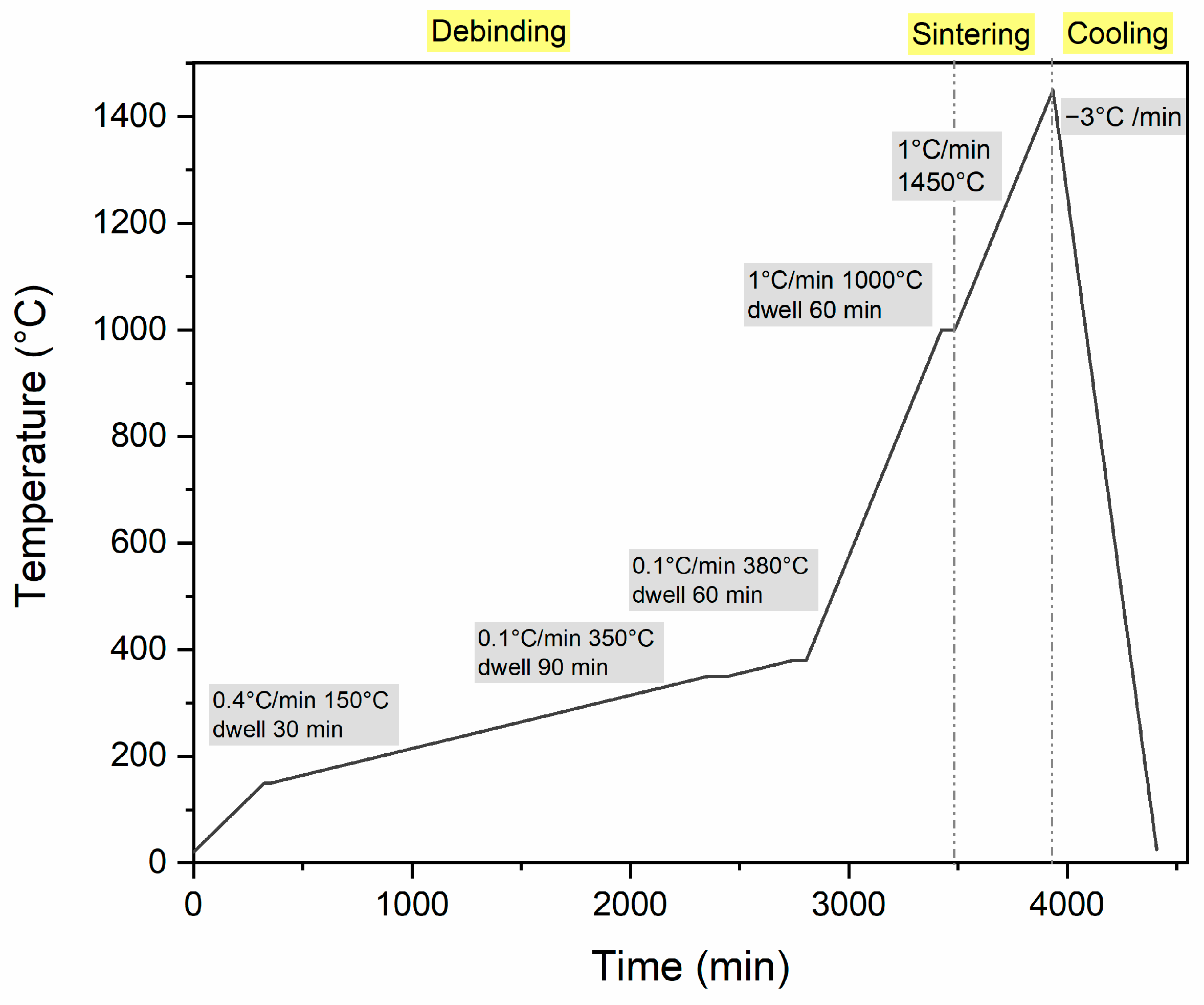
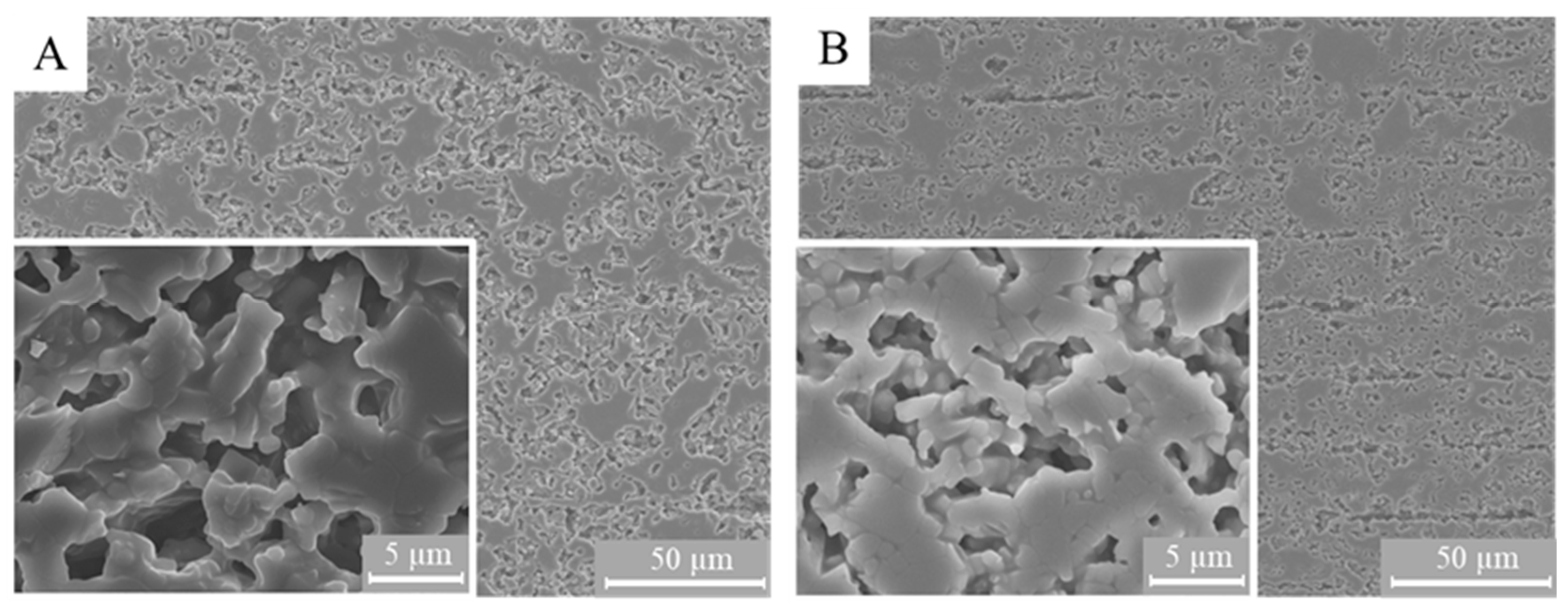
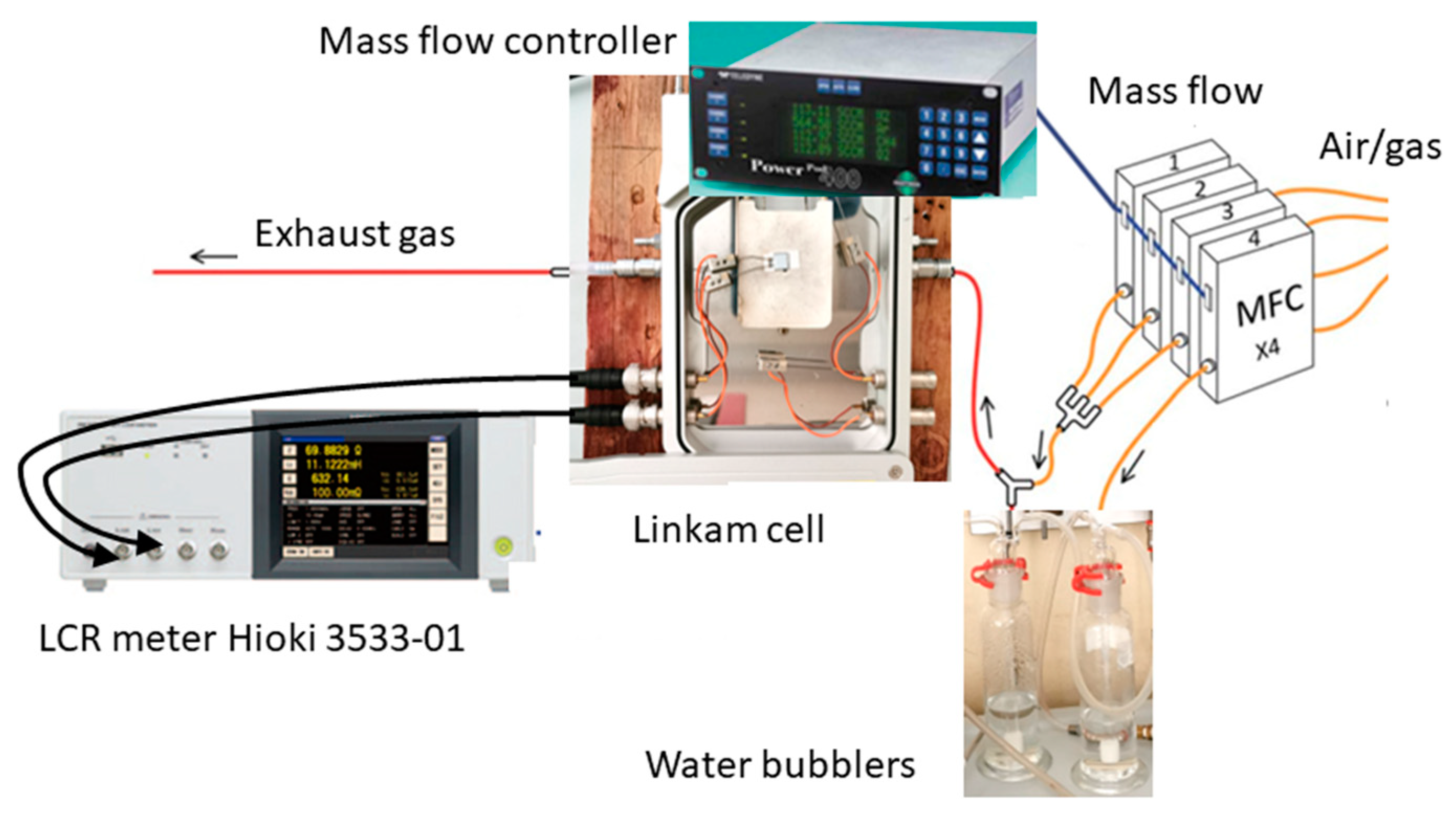
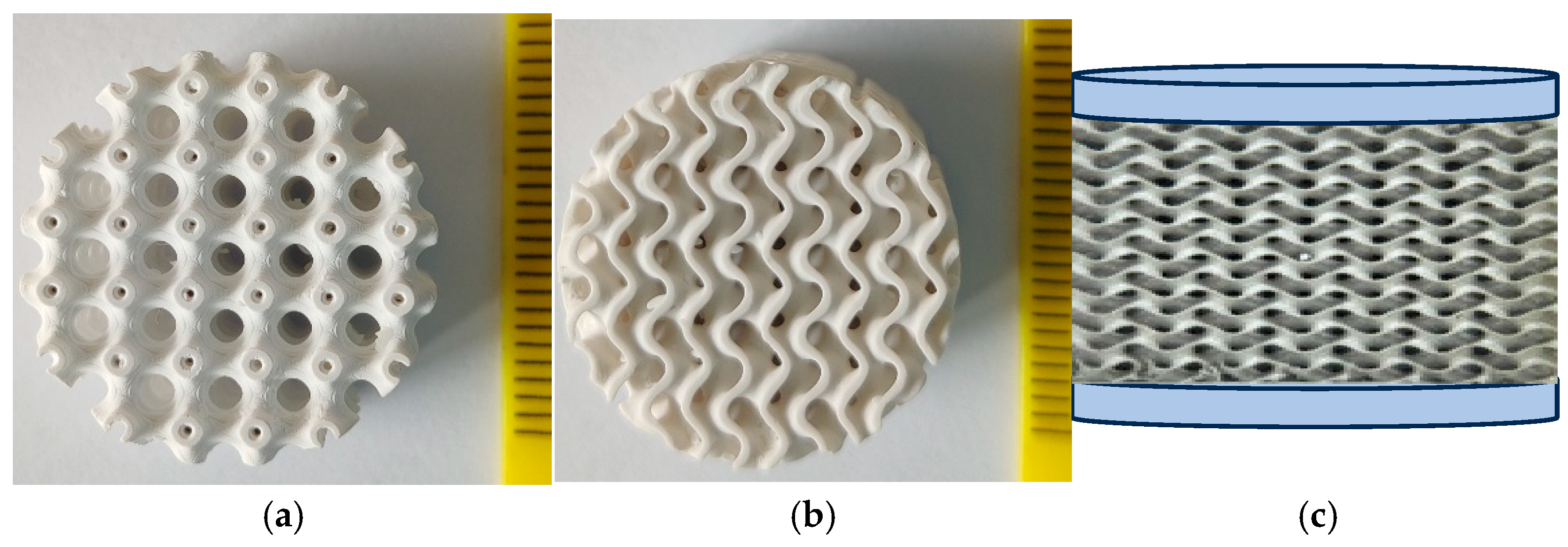

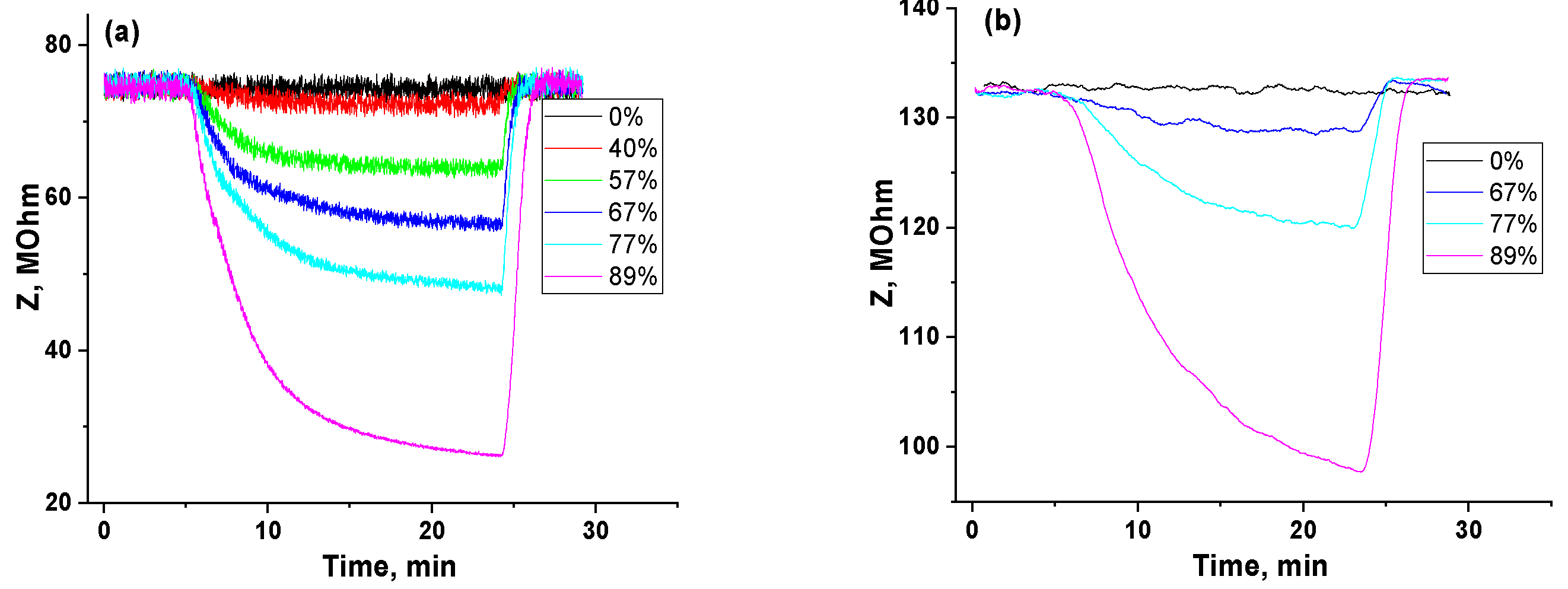
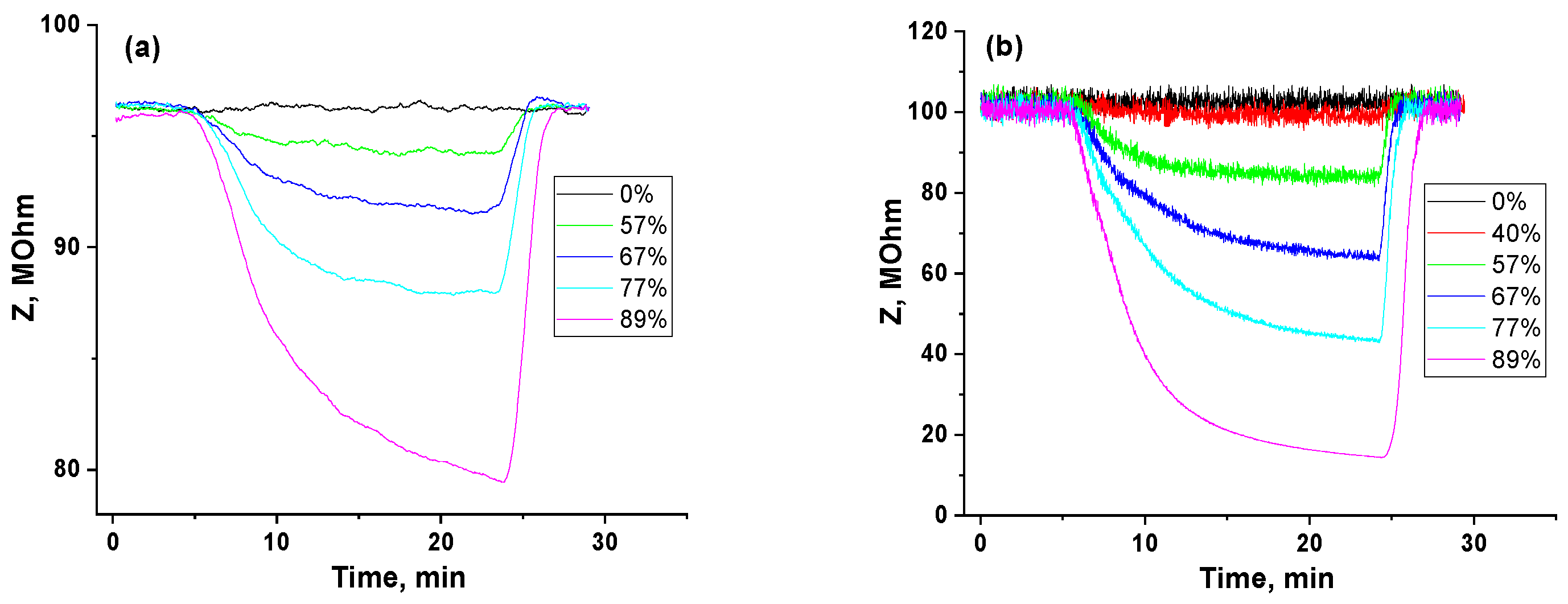
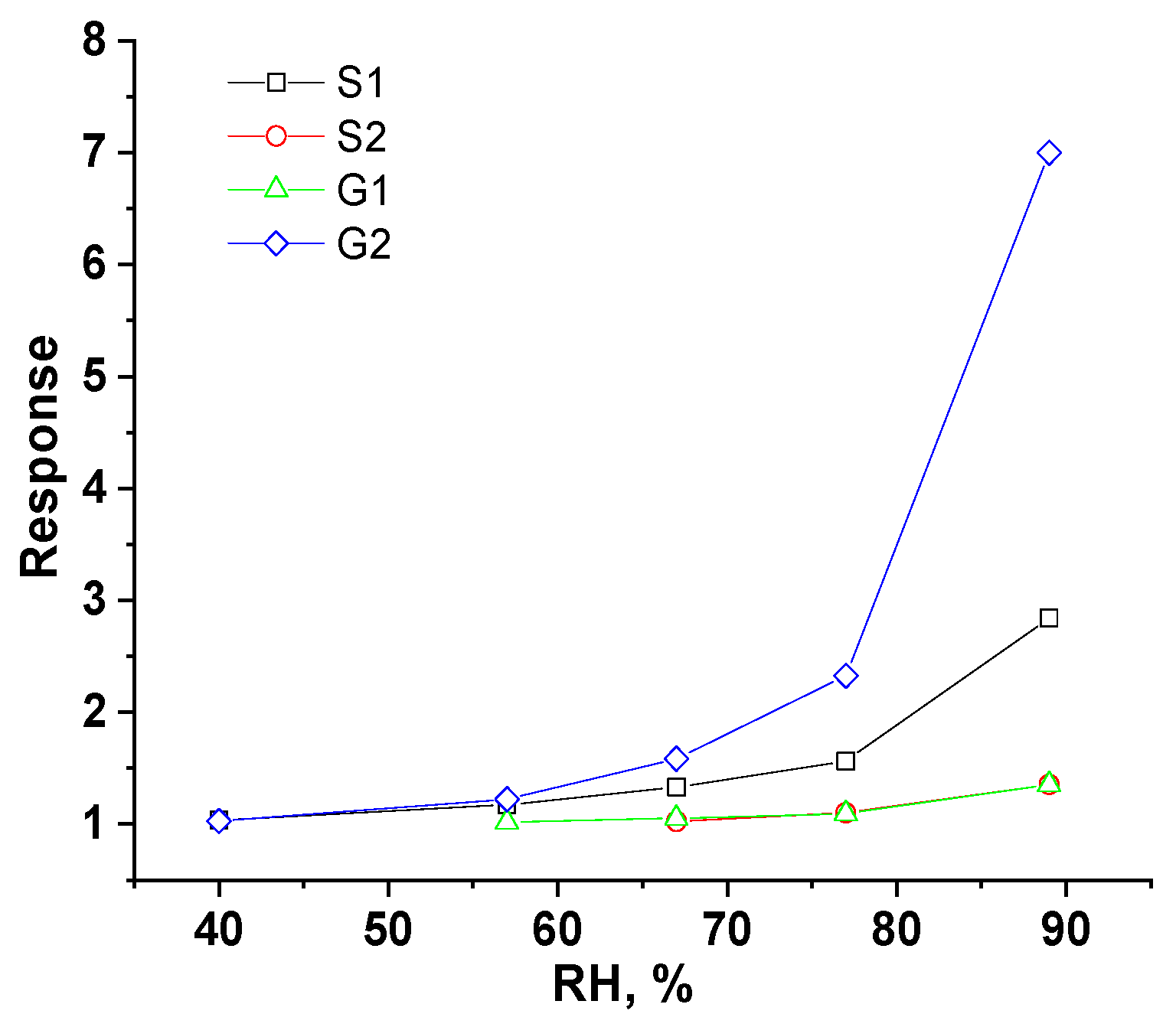
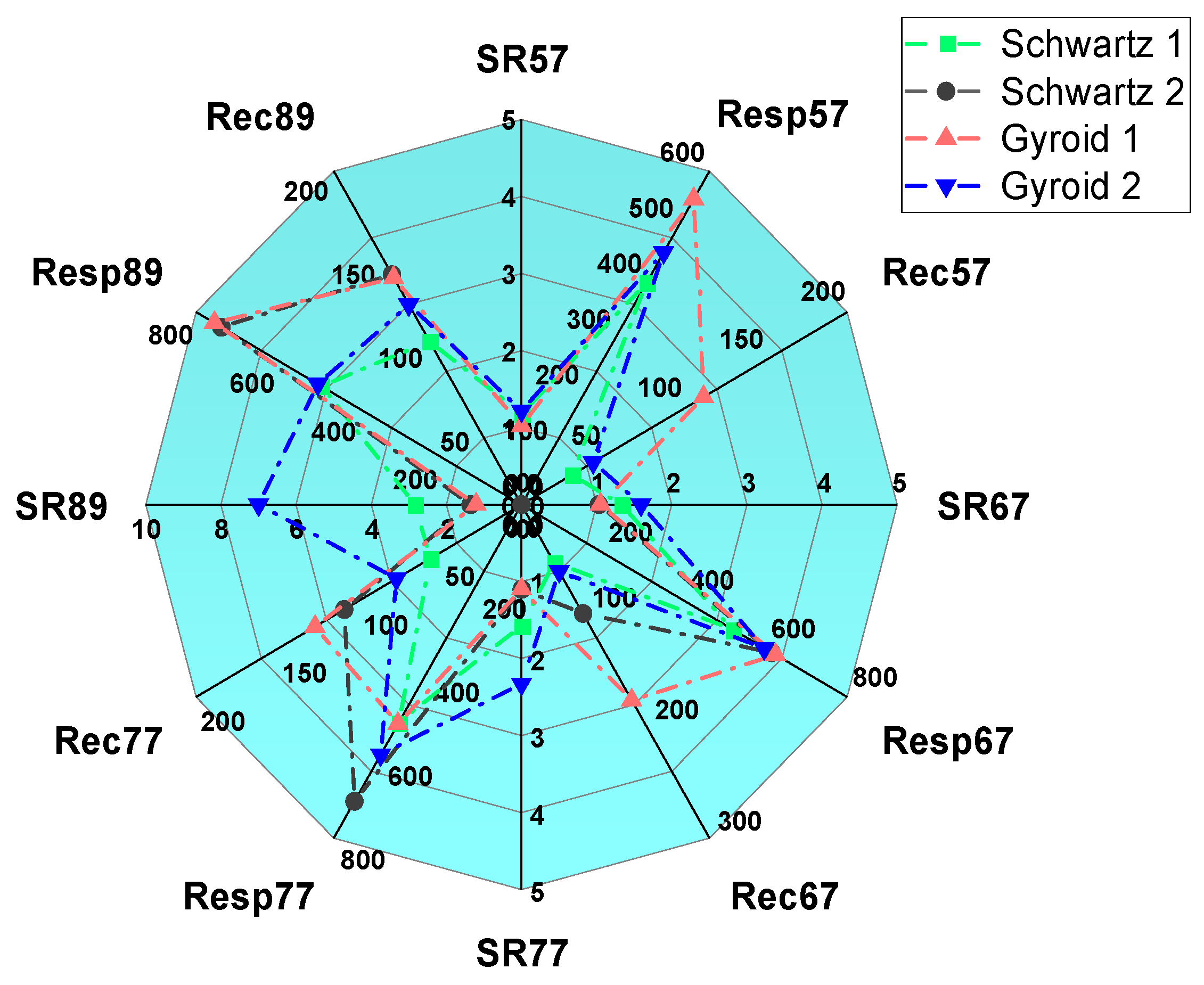
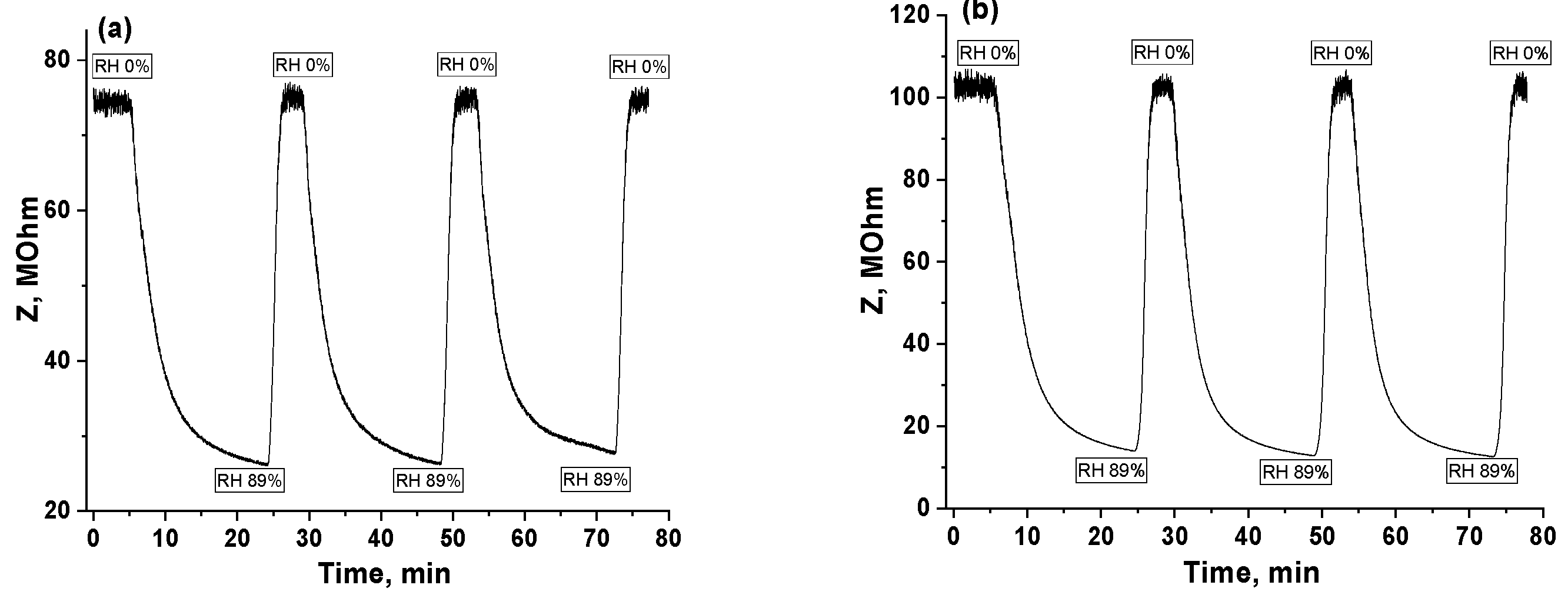
| Component | Ratio Respect to Mullite |
|---|---|
| MgO | 1:99 |
| Zirconia spheres | 6:1 |
| Water | 2:1 |
| Powder | D50, μm | Open Porosity, % | Total Pore Area, m2/g | Average Pore Diameter, μm |
|---|---|---|---|---|
| Mf | 4.4 | 32.0 | 1.0 | 0.54 |
| Mc | 9.2 | 29.1 | 0.5 | 0.87 |
| Humidity | Sensor Response (R = Zo/Zg) | Response Time, s | Recovery Time, s | |||||||||
|---|---|---|---|---|---|---|---|---|---|---|---|---|
| S1 | S2 | G1 | G2 | S1 | S2 | G1 | G2 | S1 | S2 | G1 | G2 | |
| 40% | 1.04 | 1.03 | ||||||||||
| 57% | 1.18 | 1.02 | 1.22 | 399 | 550 | 454 | 31 | 112 | 44 | |||
| 67% | 1.33 | 1.03 | 1.05 | 1.59 | 518 | 615 | 625 | 596 | 52 | 98 | 176 | 60 |
| 77% | 1.57 | 1.10 | 1.10 | 2.33 | 522 | 712 | 526 | 600 | 56 | 109 | 127 | 77 |
| 89% | 2.84 | 1.36 | 1.21 | 7.00 | 492 | 738 | 755 | 501 | 98 | 138 | 136 | 120 |
| Material | Sensor Response, R = Zo/Zg | Response Time, s | Recovery Time, s | Reference |
|---|---|---|---|---|
| CuFe2O4-Y2O3 nanocomposite | 4895 at 97% RH | 9 | 23 | [43] |
| (Ca1-xCux)HPO4.nH2O x = 0 to 1 | 51,250 at 90% RH | 29 | 283 | [45] |
| Nanosize α-Fe2O3 nanoparticles | 48,569 at 95% RH | 9 | 4 | [12] |
| GdAlO3 | 8000 at 97% RH | 45 | 60 | [46] |
| CuO-ZnO nanostructure | under (25–90)% RH | 29 | 16 | [14] |
| SnO2 thin film | 3.1 at 95% RH | 84 | 576 | [15] |
| 2D MoO3 | 4024 at 75% RH | 8 | 40 | [47] |
| 1% (La, Ce, Pr, Nd and Sm):ZnO nanocomposites | under (22–97)% RH | 62–89 | ∼300 | [16] |
| Perovskite CsPbBr3-Fe quantum dots | 1.1 at 70% RH | 38 | 38 | [48] |
| SnO2/TiO2 modified with Mo and Zn | ∼ 100 at 85% RH | 18 | 27 | [49] |
| Porous SnO2/MCM-48 | 105 at 98% RH | 9 | 12 | [50] |
| CaO nanoparticles | under (11–97)% RH | 79 | 147 | [51] |
| Pt nanoparticles decorated MoS2 nanoflakes | ∼4000 at 85% RH | 92 | 154 | [52] |
| Fe2O3/CNT | under (11–97)% RH | 17 | 25 | [13] |
| ZnO/MoS2 | ∼301 at 85% RH | 138 | 166 | [17] |
| CoHoxCr2-xO x = 0.005 to 0.02 | ∼102 at 85% RH | NA | NA | [18] |
| MgTiO3 doped with 2 wt% of LiF | 105 at 90% RH | NA | NA | [53] |
| Mn0.95Bi0.05Fe2-xHoxO4 x = 0 to 0.03 | ∼15 at 97% RH | 79 | 91 | [54] |
| NiFe2O4/CoCr2O4 | ∼10 under (11–97)% RH | 10 | 15 | [19] |
| Co1-xCdxCr2O4 x = 0 to 0.15 | ∼24 under (11–99)% RH | 14.6 | 8.6 | [55] |
| NdCoO3 | ∼50% under (11–97)% RH | 3 | NA | [11] |
| Mg0.9Rb0.1DyxFe2-xO4 x = 0 to 0.03 | under (11–98)% RH | 18 | 90 | [56] |
| MgxRb1−xFe2O4 x = 0.025 to 0.1 | ∼18 at 97% RH | 20 | 30 | [20] |
| ZnFe2 − xLuxo4 x = 0 to 0.7 | ∼10 at 97% RH | 6.5 | 35.6 | [57] |
| (1−x) NiFe2O4 /(x) Nb2O5 x = 0.10 to 0.5 | 1190 at 97% RH | 20 | 30 | [58] |
| Bi@ZnFe2O4 x = 0 to 0.05 | ∼6 at 97% RH | 79 | 91 | [59] |
| NiFe2O4 | 4 at 90% RH | NA | NA | [60] |
| ZnFe2O4 | 22 at 90% RH | NA | NA | [60] |
| Planar mullite structure | 322.9 at 85% RH | 91 | 167 | [25] |
| 3D mullite structure | 7 at 89% RH | 501 | 120 | This work |
Disclaimer/Publisher’s Note: The statements, opinions and data contained in all publications are solely those of the individual author(s) and contributor(s) and not of MDPI and/or the editor(s). MDPI and/or the editor(s) disclaim responsibility for any injury to people or property resulting from any ideas, methods, instructions or products referred to in the content. |
© 2025 by the authors. Licensee MDPI, Basel, Switzerland. This article is an open access article distributed under the terms and conditions of the Creative Commons Attribution (CC BY) license (https://creativecommons.org/licenses/by/4.0/).
Share and Cite
Milovanov, Y.; Bertero, A.; Coppola, B.; Palmero, P.; Tulliani, J.-M. Triply Periodic Minimal Surfaces Mullite Structures for Humidity Detection. Chemosensors 2025, 13, 168. https://doi.org/10.3390/chemosensors13050168
Milovanov Y, Bertero A, Coppola B, Palmero P, Tulliani J-M. Triply Periodic Minimal Surfaces Mullite Structures for Humidity Detection. Chemosensors. 2025; 13(5):168. https://doi.org/10.3390/chemosensors13050168
Chicago/Turabian StyleMilovanov, Yurii, Arianna Bertero, Bartolomeo Coppola, Paola Palmero, and Jean-Marc Tulliani. 2025. "Triply Periodic Minimal Surfaces Mullite Structures for Humidity Detection" Chemosensors 13, no. 5: 168. https://doi.org/10.3390/chemosensors13050168
APA StyleMilovanov, Y., Bertero, A., Coppola, B., Palmero, P., & Tulliani, J.-M. (2025). Triply Periodic Minimal Surfaces Mullite Structures for Humidity Detection. Chemosensors, 13(5), 168. https://doi.org/10.3390/chemosensors13050168





